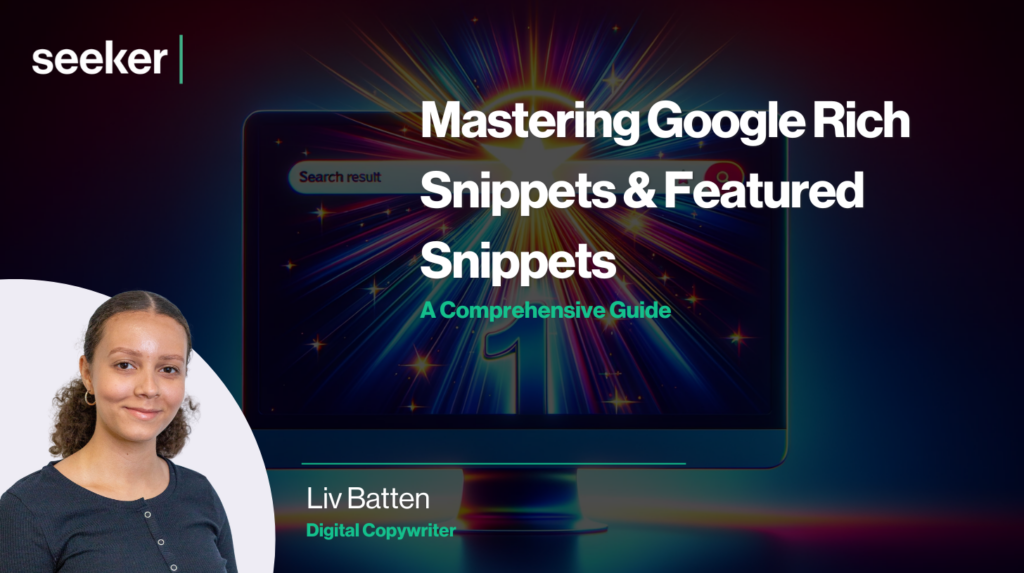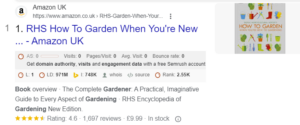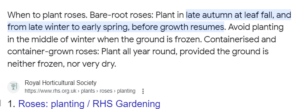
Rich snippets and featured snippets are two important functions of Google’s search results that can shine a crucial spotlight on your web content. Let’s be honest; as an internet user, when you’re searching for a quick answer, that trusty featured snippet box can save you a lot of scrolling time, whereas rich snippets — which include specific details such as ratings, reviews and prices — can help you find valuable information quickly and effortlessly.
As a website owner or digital marketer, optimising your web pages for both rich snippets and featured snippets can significantly enhance your visibility, improve your credibility, and ultimately boost your relationship with Google.
Here’s all you need to know about optimising your web pages for snippets.
What are rich snippets?
Rich Snippets are the enhanced search results displayed on Google, which offer a more detailed preview of a webpage’s content directly in the search results. These snippets go beyond the traditional blue link and meta description, giving users a glimpse of specific information such as reviews, ratings and prices.
The primary goal of a rich snippet is to present users with a more informative and relevant snapshot of the content, aiding them in making quicker decisions and promoting a higher click-through rate.

Here, the rich snippet provides extra information about the book including the rating, number of reviews, price, and availability.
Why are rich snippets important for SEO?
Enhanced visibility: Rich snippets provide additional information in search results, making your content stand out. This enhanced visibility can lead to a higher click-through rate (CTR) as users are more likely to click on results that provide more information at a glance.
Increased click-through rates (CTR): The extra information displayed in rich snippets, such as star ratings or pricing, can attract users’ attention and encourage them to click on your result. A higher CTR is a positive signal to search engines and can contribute to improved rankings.
Improved user experience: Rich snippets offer users a preview of what they can expect on a web page. This preview helps users make more informed decisions about which result is most relevant to their query, contributing to a better overall user experience.
Increased authority and credibility: Appearing in rich snippets, especially for specific content types like reviews or recipes, can enhance your website’s authority and credibility. Google often selects content that is well-structured and provides valuable information, signaling to users that your site is a reliable source.
Competitive advantage: Rich snippets set your content apart from other search results by presenting additional information. This can be a powerful way to differentiate your site and attract users who are looking for detailed and relevant information.
Adaptation to voice search: As voice search becomes more prevalent, rich snippets become even more crucial. Voice assistants often rely on structured data to provide concise and relevant answers, making content with rich snippets more likely to be featured in voice search results.
Diverse content representation: Rich snippets support various content types, including reviews, recipes, events, and more. By optimising for rich snippets, you can ensure that your content is eligible for diverse search features, increasing your chances of being showcased in different formats.
Types of rich snippets
The first thing you need to do is identify which types of rich snippets you’re aiming for. That way, you can use structured schema markup that’s specifically designed to get that type of rich snippet in the SERPs.
The main types of rich snippets include:
Reviews: Displaying ratings and individual reviews for products, services, or businesses enhances trust and provides users with a quick overview of others’ experiences.
Recipes: Featuring cooking times, ingredients, and step-by-step instructions for recipes is appealing to users searching for specific culinary instructions.
Events: Showcasing details about upcoming events, including dates, times, and locations is useful for promoting and publicising events directly on the search results page.
Products: Highlighting specific product information such as prices, availability, and reviews aids users in making informed decisions before clicking through to a website.
People: Displaying information about individuals, including biographical details, occupation, and social media profiles is useful for personal branding and showcasing professional expertise.
Video: Providing video previews and information about video content increases visibility for video-based content directly in search results.
Local businesses: Showcasing details about local businesses, including address, contact information, and reviews is essential for businesses seeking to attract local customers.
Music: Displaying information about songs, albums, and artists enhances the discoverability of music-related content.
How to optimise content for Google rich snippets
- Create structured data markup with Schema.org: Implement Schema.org vocabulary to provide context and additional information to search engines. Your markup should be tailored to specific content types, such as recipes, reviews, or events, increasing the likelihood of being featured in relevant rich snippets — there are plenty of useful schema plugins that can help, particularly if you’re using WordPress. This strategic use of structured data enhances the clarity and relevance of your content in the eyes of search algorithms.
- Optimise your multimedia content: While Google can’t ‘watch’ your videos, optimising them with clear video titles, visual appeal, and video makeup can help search engines understand what your video content is about. Engaging multimedia not only makes your content more appealing but also increases the chances of being featured in image or video snippets.
- Allow reviews on your site: Certain rich snippets, such as those for products or local businesses, often include review-related information. Allowing and showcasing reviews on your site ensures that your content is eligible for a broader range of rich snippets, while improving click-through rates since credibility is increased.
How to do data markup for rich snippets
Structured data markup is crucial for optimising your content and increasing the chances of being featured in rich snippets on search engine results pages (SERPs). Here’s a step-by-step guide for beginners:
Step 1: Understand structured data: Before diving in, do a little research into structured data so you understand how it works — it’s a standardised format providing additional context to search engines about your content.
Step 2: Identify rich snippet opportunities: Determine the type of rich snippet you want to target. Whether it’s reviews, recipes, events, products, or others, understanding your content’s nature guides the structured data you need to implement.
Step 3: Use schema markup generator tools: Leverage online tools like Google’s Structured Data Markup Helper or Schema.org’s Markup Generator. Enter the necessary details for your content type, and these tools generate HTML markup code for you.
Step 4: Implement structured data in HTML: Insert the generated markup code into the HTML of your webpage. This is often done within the <head> or <body> section. If you’re using a content management system (CMS), there might be plugins available to simplify this process.
Step 5: Validate your markup: Use Google’s Structured Data Testing Tool to check if your structured data is error-free. This tool helps ensure that search engines can interpret and display your data correctly.
Step 6: Monitor search console: If you haven’t already, set up Google Search Console for your website. This tool provides insights into how Google sees and understands your structured data. Monitor for any issues or improvements suggested by Search Console.
Step 8: Stay updated with algorithm changes: Search engine algorithms evolve, and so do rich snippet opportunities. Stay informed about changes, updates, and new types of snippets. Regularly revisit and update your structured data to align with best practices.
What are featured snippets?
Featured snippets are positioned at the top of the SERPs, and take user experience one step further than standard search results by providing concise and direct answers to user queries. Google aims to answer the user’s question immediately, so securing this prime spot indicates the value of your site and ensures your content gets maximum visibility.

Here, the featured snippet pulls a concise answer to the users search query from the most relevant web page.
Why are featured snippets important for SEO?
Position zero visibility: Featured snippets appear at the top of the search results, earning the coveted ‘position zero’. This prime placement offers maximum visibility, capturing user attention before they even scroll down to traditional search results.
Enhanced authority: Google selects content for featured snippets based on perceived authority and relevance. Being featured here positions your brand as a thought leader in its niche, enhancing your website’s reputation and influencing overall search rankings.
Increased brand recognition: Being featured in a snippet reinforces your brand’s presence and authority. Users are more likely to remember and trust a brand that consistently provides valuable and concise information.
More website traffic: Securing a featured snippet can increase website traffic since your snippet is the first result that users see. Instead of scrolling further, users are more likely to explore the top few results which means more people on your site.
Types of featured snippets
The main types of featured snippets include:
- Paragraph snippets: These concise blocks of text directly answer a user’s query, providing a quick and informative response. Google selects a relevant passage from a webpage that best addresses the user’s question, displaying it prominently at the top of the search results for quick access to information — they are commonly used for general knowledge queries, explanations, and brief overviews.
- List snippets: List snippets present information in bulleted or numbered lists. This format is ideal for step-by-step instructions, rankings, or any content that benefits from an itemised presentation. It’s a great way of providing a user-friendly way to consume information in a structured and easily digestible format.
- Table snippets: This type of snippet is beneficial for presenting comparative data and specifications in a table format, offering a structured overview of the information.
- Video snippets: Whether through previews or direct links to relevant videos, these snippets cater to users seeking visual information. Video snippets are valuable for content creators who produce video content, allowing them to showcase their material directly on the search engine results page and potentially increase click-through rates.
How to optimise content for Google featured snippets
- Organise your content structure and formatting: Optimising your content structure is an important part of on-page SEO and significantly influences snippet selection. Organise your content logically with clear headings and subheadings, using a hierarchical structure (H1, H2, H3, etc.) so it’s easy for readers to digest and algorithms to understand.
- Conduct keyword research for featured snippet optimisation: Identify relevant and frequently searched queries within your niche, prioritising long-tail keywords and questions aligning with user intent. You should then craft content that directly addresses these queries, as Google often selects precise and informative answers for featured snippet positions.
- Answer user queries clearly: Crafting clear and concise answers directly within your content is pivotal for featured snippets. Position your answers prominently, preferably near the beginning of the content. By providing succinct and relevant information upfront, you increase the likelihood of Google selecting your content to fulfill user queries directly in the search results.
- Use bulleted and numbered lists: Presenting information in either bulleted or numbered lists enhances snippet eligibility as it’s easier for both users and search engines to extract and understand information quickly. When crafting content, consider incorporating lists where appropriate, facilitating easier snippet selection for Google.
FAQ
What’s the difference between featured snippets and rich snippets?
Featured snippets and rich snippets are both types of enhanced search results, but they serve different purposes. Rich snippets provide additional information such as star ratings, prices, or event details directly in search results. They enhance the appearance of a search result but don’t necessarily answer a specific query. On the other hand, featured snippets aim to directly answer user queries by providing concise information at the top of the search results, often in the form of a paragraph, list, or table.
Are featured snippets hard to get?
Securing featured snippets can be competitive, but focusing on good SEO practices will enhance your chances. Success depends on various factors, including the quality and relevance of your content, how well it addresses user queries, and the optimisation of your content for snippet formats. However, the dynamic nature of search algorithms means that ongoing optimisation is crucial for maintaining and improving your position.
Why do featured snippets disappear?
Featured snippets can disappear for several reasons. Google continuously refines its algorithms, and changes in search behavior or content quality can influence which results are displayed. If your content is no longer the most relevant or there are improvements in competing content, your featured snippet may be replaced by an alternative.
How long does it take to get a featured snippet?
The time it takes to secure a featured snippet varies. Google determines featured snippets based on factors like content quality, relevance, and optimisation for snippet formats. While there’s no fixed timeline, following SEO best practices can speed up the process.
Can you have both rich and featured snippets simultaneously?
It’s possible to have both rich and featured snippets simultaneously. Rich snippets enhance search results by providing additional information, while featured snippets aim to answer user queries directly at the top of search results. Effective implementation of structured data markup and adherence to SEO best practices increase the chances of appearing in both types of enhanced search results.
Want to improve your site’s SEO and secure featured snippets and rich snippets on Google? Let Seeker’s SEO and content experts work their magic! Get in touch with us today to find out more about our SEO services.
